Recent Development and Perspectives of Optimization Design Methods for Piezoelectric Ultrasonic Transducers
Abstract
:1. Introduction
2. Traditional Optimization Design Methods for a PUT
2.1. Analytical Model
2.2. Equivalent Circuit Model
2.3. Finite Element Model
3. Efficient Optimization Design Methods for a PUT
3.1. Optimization Design Methods Based on Traditional Models
3.2. Optimization Design Methods Based on a Data-Driven Model
4. Comparison and Discussion
5. Conclusions and Perspectives
- (1)
- The predictive model is very important for the design accuracy of a PUT; therefore, a high-precision predictive model should be developed based on traditional models.
- (2)
- A large amount of original data should be accumulated to establish the database, which can be used to train data-driven models.
- (3)
- Efficient optimization design strategies or algorithms should be developed to further improve the efficiency of the optimization design for a PUT.
- (4)
- Efficient optimization design software should be developed by integrating the predictive models and intelligent optimization algorithms.
- (5)
Author Contributions
Funding
Conflicts of Interest
References
- Tao, R. Electric-field-induced phase transition in electrorheological fluids. Phys. Rev. E 1993, 47, 423–426. [Google Scholar] [CrossRef] [PubMed]
- Zhang, J.; Meguid, S.A. Piezoelectricity of 2D nanomaterials: Characterization, properties, and applications. Semicond. Sci. Tech. 2017, 32, 043006. [Google Scholar] [CrossRef]
- Zhou, Q.; Lam, K.H.; Zheng, H.; Qiu, W.; Shung, K.K. Piezoelectric single crystal ultrasonic transducers for biomedical applications. Prog. Mater. Sci. 2014, 66, 87–111. [Google Scholar] [CrossRef] [PubMed] [Green Version]
- Jia, H.; Li, H.; Lin, B.; Hu, Y.; Peng, L.; Xu, D.; Cheng, X. Fine scale 2-2 connectivity PZT/epoxy piezoelectric fiber composite for high frequency ultrasonic application. Sens. Actuators A Phys. 2021, 324, 112672. [Google Scholar] [CrossRef]
- Chen, Y.; Chen, Y.; Hu, S.; Ni, Z. Continuous ultrasonic flow measurement for aerospace small pipelines. Ultrasonics 2021, 109, 106260. [Google Scholar] [CrossRef]
- Peng, C.; Wu, H.; Kim, S.; Dai, X.; Jiang, X. Recent advances in transducers for intravascular ultrasound (IVUS) imaging. Sensors 2021, 21, 3540. [Google Scholar] [CrossRef] [PubMed]
- Kai, Y.; Rongong, J.A.; Keith, W. Damage detection in a laboratory wind turbine blade using techniques of ultrasonic NDT and SHM. Strain 2018, 54, e12290. [Google Scholar]
- Chen, Z.; Qian, X.; Song, X.; Jiang, Q.; Huang, R.; Yang, Y.; Li, R.; Shung, K.; Chen, Y.; Zhou, Q. Three-Dimensional Printed Piezoelectric Array for Improving Acoustic Field and Spatial Resolution in Medical Ultrasonic Imaging. Micromachines 2019, 10, 170. [Google Scholar] [CrossRef] [Green Version]
- Xu, J.; Deng, H.; Zeng, Z.; Zhang, Z.; Zhao, K.; Chen, J.; Nakamori, N.; Wang, F.; Ma, J.; Li, X.; et al. Piezoelectric performance enhancement of Pb(Mg1/3Nb2/3)O3-0.25PbTiO3 crystals by alternating current polarization for ultrasonic transducer. Appl. Phys. Lett. 2018, 112, 182901. [Google Scholar] [CrossRef]
- Mozaffarzadeh, M.; Minonzio, C.; De, J.N.; Verweij, M.D.; Hemm, S.; Renaud, G.; Daeichin, V. Erratum: Lamb Waves and Adaptive Beamforming for Aberration Correction in Medical Ultrasound Imaging. IEEE Trans. Ultrason. Ferroelectr. Freq. Control. 2020, 68, 352–353. [Google Scholar] [CrossRef]
- Qu, Y.; Ma, T.; He, Y.; Yu, M.; Zhu, J.; Miao, Y.; Dai, C.; Patel, P.; Shung, K.K.; Zhou, Q.; et al. Miniature probe for mapping mechanical properties of vascular lesions using acoustic radiation force optical coherence elastography. Sci. Rep. 2017, 7, 4731. [Google Scholar] [CrossRef] [PubMed] [Green Version]
- Ding, X.; Li, P.; Lin, S.S.; Zackary, S.S.; Nama, N.; Guo, F.; Slotcavage, D.; Mao, X.; Shi, J.; Costanzo, F.; et al. Surface acoustic wave microfluidics. R. Soc. Chem. 2013, 13, 3626–3649. [Google Scholar] [CrossRef] [PubMed]
- Zhu, B.; Xu, J.; Li, Y.; Wang, T.; Xiong, K.; Lee, C.; Yang, X.; Shiiba, M.; Takeuchi, S.; Zhou, Q.; et al. Micro-particle manipulation by single beam acoustic tweezers based on hydrothermal PZT thick film. AIP Adv. 2016, 6, 035102. [Google Scholar] [CrossRef] [PubMed]
- Feeney, A.; Kang, L.; Somerset, W.E.; Dixon, S. The Influence of Air Pressure on the Dynamics of Flexural Ultrasonic Transducers. Sensors 2019, 19, 4710. [Google Scholar] [CrossRef] [PubMed] [Green Version]
- Peng, C.; Chen, M.; Sim, H.K.; Zhu, Y.; Member, S.; Jiang, X. Noninvasive and Nonocclusive Blood Pressure Monitoring via a Flexible Piezo-composite Ultrasonic Sensor. IEEE Sens. J. 2021, 21, 2642–2650. [Google Scholar] [CrossRef]
- Canning, S.; Walker, A.J.; Roach, P.A. A Mathematical Model of a Novel 3D Fractal-Inspired Piezoelectric Ultrasonic Transducer. Sensors 2016, 16, 2170. [Google Scholar] [CrossRef] [Green Version]
- Yu, Y.; Zhang, Z.; Cai, F.; Su, M.; Jiang, Q.; Zhou, Q.; Humayun, M.S.; Qiu, W.; Zheng, H. A Novel Racing Array Transducer for Noninvasive Ultrasonic Retinal Stimulation: A Simulation Study. Sensors 2019, 19, 1825. [Google Scholar] [CrossRef] [Green Version]
- Zhang, X.; Lin, S.; Yong, W. Three-dimensional coupled vibration theory for the longitudinally polarized piezoelectric ceramic tube. Appl. Acoust. 2015, 91, 59–63. [Google Scholar] [CrossRef]
- Danilov, V.N.; Artem’ev, S.A.; Zakharov, A.F. Operation of a model of a normal ultrasonic transducer for immersion and conventional inspection techniques. Russ. J. Nondestruct. Test. 2007, 43, 353–364. [Google Scholar] [CrossRef]
- Gorostiaga, M.; Wapler, M.C.; Wallrabe, U. Optimizing piezoelectric receivers for acoustic power transfer applications. Smart Mater. Struct. 2018, 27, 075024. [Google Scholar] [CrossRef]
- Shih, C.; Qian, X.; Ma, T.; Han, Z.; Huang, C.C.; Zhou, Q.; Shung, K.K. Quantitative assessment of thin-layer tissue viscoelastic properties using ultrasonic micro-elastography with Lamb wave model. IEEE T. Med. Imaging 2018, 37, 1887–1898. [Google Scholar] [CrossRef]
- Krimholtz, R.; Leedom, D.A.; Matthaei, G.L. New equivalent circuits for elementary piezoelectric transducers. Electron. Lett. 1970, 6, 398–399. [Google Scholar] [CrossRef]
- Sherrit, S.; Leary, S.P.; Dolgin, B.P.; Bar-Cohen, Y. Comparison of the Mason and KLM equivalent circuits for piezoelectric resonators in the thickness mode. In Proceedings of the 1999 IEEE Ultrasonics Symposium, Caesars Tahoe, NV, USA, 17–20 October 1999; pp. 921–926. [Google Scholar]
- Castillo, M.; Acevedo, P.; Moreno, E. KLM model for lossy piezoelectric transducers. Ultrasonics 2003, 41, 671–679. [Google Scholar] [CrossRef]
- Jamneala, T.; Bradley, P.; Koelle, U.B.; Chien, A. Modified mason model for bulk acoustic wave resonators. IEEE Trans. Ultrason. Ferroelectr. Freq. Control. 2008, 55, 2025–2029. [Google Scholar] [CrossRef] [PubMed]
- Ou-Yang, J.; Zhu, B.; Zhang, Y.; Chen, S.; Yang, X.; Wei, W. New KNN-based lead-free piezoelectric ceramic for high-frequency ultrasound transducer applications. Appl. Phys. A 2015, 118, 1177–1181. [Google Scholar] [CrossRef]
- Kar, B.; Wallrabe, U. Performance Enhancement of an Ultrasonic Power Transfer System Through a Tightly Coupled Solid Media Using a KLM Model. Micromachines 2020, 11, 355. [Google Scholar] [CrossRef] [Green Version]
- Fei, C.; Li, Y.; Zhu, B.; Chiu, C.T.; Chen, Z.; Li, D.; Yang, Y.; Kirk, S.K.; Zhou, Q. Contactless microparticle control via ultrahigh frequency needle type single beam acoustic tweezers. Appl. Phys. Lett. 2016, 109, 173509. [Google Scholar] [CrossRef] [PubMed] [Green Version]
- Deng, X.; Xu, T.; Huang, G.; Li, Q.; Luo, L.; Zhao, Y.; Wu, Z.; Ou-Yang, J.; Yang, X.; Xie, M.; et al. Design and fabrication of a novel dual-frequency confocal ultrasound transducer for microvessels super-harmonic imaging. IEEE Trans. Ultrason. Ferroelectr. Freq. Control. 2021, 68, 1272–1277. [Google Scholar] [CrossRef] [PubMed]
- Chao, Z.; Wang, L.; Lei, Q.; Sun, S.; Xing, L. The theoretical model of 1–3 piezocomposite transducer with matching layer. Ferroelectrics 2020, 554, 97–103. [Google Scholar] [CrossRef]
- Sun, X.; Fei, C.; Chen, Q.; Li, D.; Tang, Z.; Zhuang, J.; Wu, Y.; Chen, J.; Wu, R.; Yang, Y. Dy-doped BiFeO3-PbFeO3-based piezoelectric ceramics for nondestructive testing ultrasonic transducer applications. J. Mater. Sci. Mater. El. 2020, 31, 1839–1845. [Google Scholar] [CrossRef]
- Quan, Y.; Fei, C.; Ren, W.; Wang, L.; Niu, G.; Zhao, J.; Zhuang, J.; Zhang, J.; Zheng, K.; Lin, P.; et al. Lead-free KNN-based Textured Ceramics for High Frequency Ultrasonic Transducer Application. IEEE Trans. Ultrason. Ferroelectr. Freq. Control. 2021, 68, 1979–1987. [Google Scholar] [CrossRef]
- Hori, Y.; Fujimori, K.; Tsuruta, K.; Nogi, S. Design and development of highly efficient transducer for ultrasonic wireless power transmission system. IEEJ Trans. Electron. Inf. Syst. 2013, 184, 27–35. [Google Scholar] [CrossRef]
- Bybi, A.; Mouhat, O.; Garoum, M.; Drissi, H.; Grondel, S. One-dimensional equivalent circuit for ultrasonic transducer arrays. Appl. Acoust. 2019, 156, 219. [Google Scholar] [CrossRef]
- Smyth, K.; Kim, S. Experiment and simulation validated analytical equivalent circuit model for piezoelectric micromachined ultrasonic transducers. IEEE Trans. Ultrason. Ferroelectr. Freq. Control. 2015, 62, 744–765. [Google Scholar] [CrossRef] [Green Version]
- Hou, S.; Yang, X.; Fei, C.; Sun, X.; Chen, Q.; Lin, P.; Li, D.; Yang, Y.; Zhou, Q. Fabrication of PMN-PT/Epoxy 2–2 Composite Ultrasonic Transducers and Analysis Based on Equivalent Circuit Model. J. Electron. Mater. 2018, 47, 6842–6847. [Google Scholar] [CrossRef]
- Fei, C.; Lin, P.; Li, D.; Wu, Y.; Wu, R.; Chen, J.; Yang, Y. Fabrication and Characterization of High-Sensitivity Ultrasonic Transducers with Functionally Graded Design. IEEE Sens. J. 2019, 19, 6650–6654. [Google Scholar] [CrossRef]
- Li, J.; Liu, P.; Ding, H.; Cao, W. Modeling characterization and optimization design for PZT transducer used in Near Field Acoustic Levitation. Sens. Actuators A Phys. 2011, 171, 260–265. [Google Scholar] [CrossRef]
- Li, D.; Fei, C.; Zhang, Q.; Li, Y.; Yang, Y.; Zhou, Q. Ultrahigh Frequency Ultrasonic Transducers Design with Low Noise Amplifier Integrated Circuit. Micromachines 2018, 9, 515. [Google Scholar] [CrossRef] [PubMed] [Green Version]
- Lin, P.; Zhang, L.; Fei, C.; Li, D.; Wu, R.; Chen, Q.; Hou, C.; Yang, Y. Novel multi-layer-composites design for ultrasonic transducer applications. Compos. Struct. 2020, 245, 112364. [Google Scholar] [CrossRef]
- Liu, S.; Zhang, Z.; Xu, J.; Xiao, J.; Wang, X.; Luo, H. Optimizing dual-piezoelectric-layer ultrasonic transducer via systematic analysis. Sens. Actuators A Phys. 2020, 315, 112336. [Google Scholar] [CrossRef]
- Kim, T.; Cui, Z.; Chang, W.; Kim, H.; Zhu, Y.; Jiang, X. Flexible 1-3 Composite Ultrasound Transducers with Silver Nanowire-based Stretchable Electrodes. IEEE T. Ind. Electron. 2020, 67, 6955–6962. [Google Scholar] [CrossRef]
- Bruno, B.P.; Fahmy, A.R.; Sturmer, M.; Wallrabe, U.; Wapler, M.C. Properties of piezoceramic materials in high electric field actuator applications. Smart Mater. Struct. 2019, 28, 015029. [Google Scholar] [CrossRef]
- Zhang, Z.; Xu, J.; Yang, L.; Liu, L.; Xiao, J.; Li, X.; Wang, X.; Luo, H. Design and comparison of PMN-PT single crystals and PZT ceramics based medical phased array ultrasonic transducer. Sens. Actuators A Phys. 2018, 283, 273–281. [Google Scholar] [CrossRef]
- Peng, H.; Qian, X.; Mao, L.; Jiang, L.; Sun, Y.; Zhou, Q. Ultrafast ultrasound imaging in acoustic microbubble trapping. Appl. Phys. Lett. 2019, 115, 203701. [Google Scholar] [CrossRef]
- Li, Z.; Guo, R.; Fei, C.; Li, D.; Chen, D.; Zheng, C.; Wu, R.; Feng, W.; Yang, Y. Liquid lens with adjustable focus for ultrasonic imaging. Appl. Acoust. 2021, 175, 107787. [Google Scholar] [CrossRef]
- Benoît, P.; Dominique, L.; Sylvain, C.; Pierre, C. Optimization of ultrasonic arrays design and setting using a differential evolution. NDT E Int. 2011, 44, 797–803. [Google Scholar]
- Choi, E.; Roh, Y. Optimal Design of a Concave Annular High Intensity Focused Ultrasound Transducer for Medical Treatment. Sens. Actuators A Phys. 2017, 263, 91–101. [Google Scholar] [CrossRef]
- Chen, D.; Zhao, J.; Fei, C.; Li, D.; Zhu, Y.; Li, Z.; Guo, R.; Lou, L.; Feng, W.; Yang, Y. Particle Swarm Optimization Algorithm-Based Design Method for Ultrasonic Transducers. Micromachines 2020, 11, 715. [Google Scholar] [CrossRef]
- Rubio, W.M.; Flávio, B.; Adamowski, J.C.; Emílio, C.N.S. Topology optimized design of functionally graded piezoelectric ultrasonic transducers. Phys. Procedia 2010, 3, 891–896. [Google Scholar] [CrossRef] [Green Version]
- Chen, D.; Zhao, J.; Fei, C.; Li, D. An Efficient Optimization Design for 1 MHz Ultrasonic Transmitting Transducer. IEEE Sens. J. 2021, 6, 7420–7427. [Google Scholar] [CrossRef]
- Chen, D.; Hou, C.; Fei, C.; Li, D.; Lin, P.; Chen, J.; Yang, Y. An optimization design strategy of 1-3 piezocomposite ultrasonic transducer for imaging applications. Mater. Today Commun. 2020, 24, 100991. [Google Scholar] [CrossRef]
- Li, Z.; Chen, D.; Fei, C.; Li, D.; Feng, W.; Yang, Y. Optimization design of ultrasonic transducer with multi-matching layer. IEEE Trans. Ultrason. Ferroelectr. Freq. Control. 2021. [Google Scholar] [CrossRef]
- Li, Z.; Guo, R.; Chen, D.; Fei, C.; Yang, X.; Li, D.; Zheng, C.; Chen, J.; Wu, R.; Feng, W.; et al. An Efficient Optimization Design of Liquid Lens for Acoustic Pattern Control. IEEE Trans. Ultrason. Ferroelectr. Freq. Control. 2021, 68, 1546–1554. [Google Scholar] [CrossRef] [PubMed]
- Man, J.; Sun, X.; Chen, D.; Fei, C. Intelligent optimization of matching layers for piezoelectric ultrasonic transducer. IEEE Sens. J. 2021. [Google Scholar] [CrossRef]
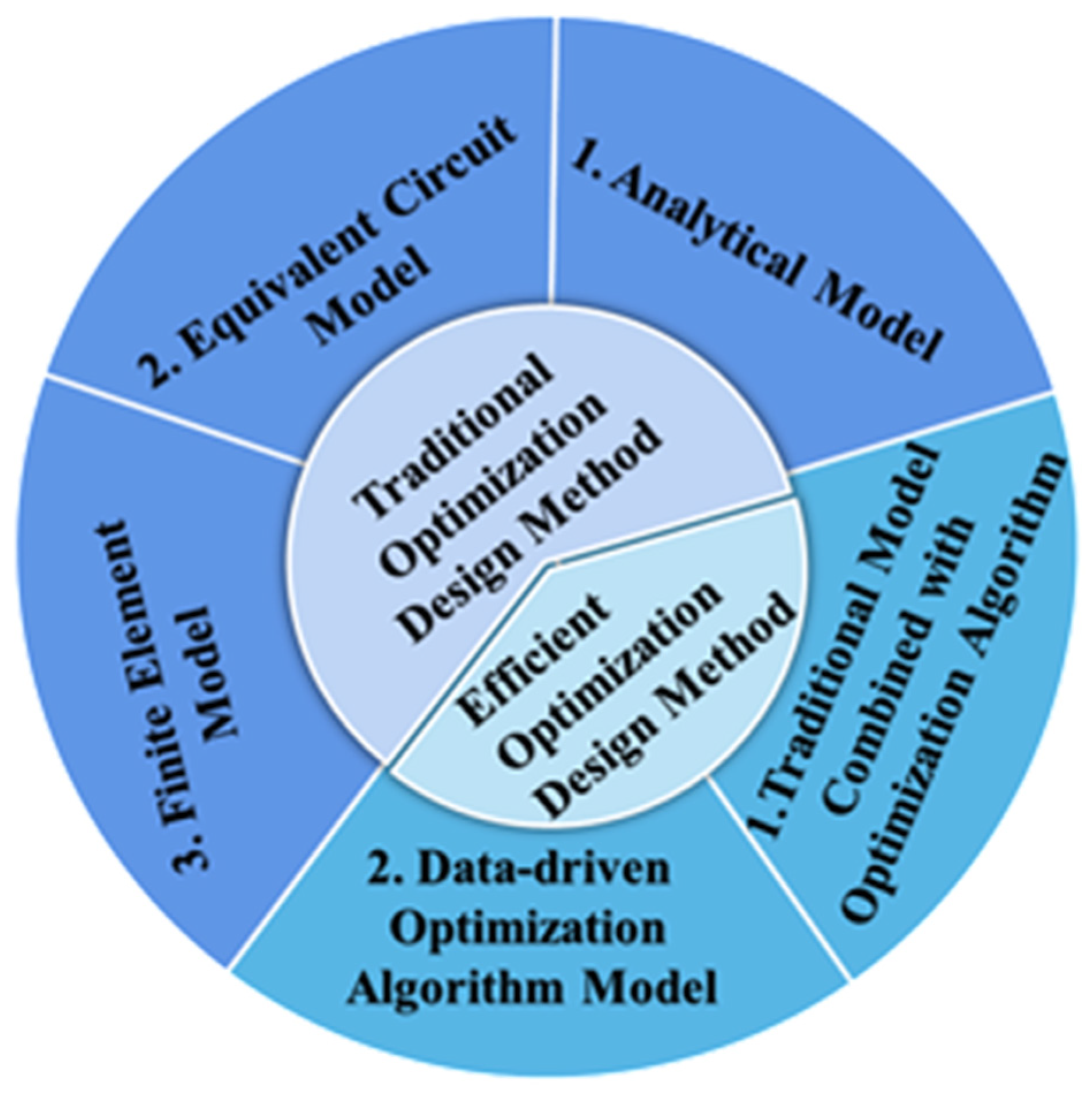
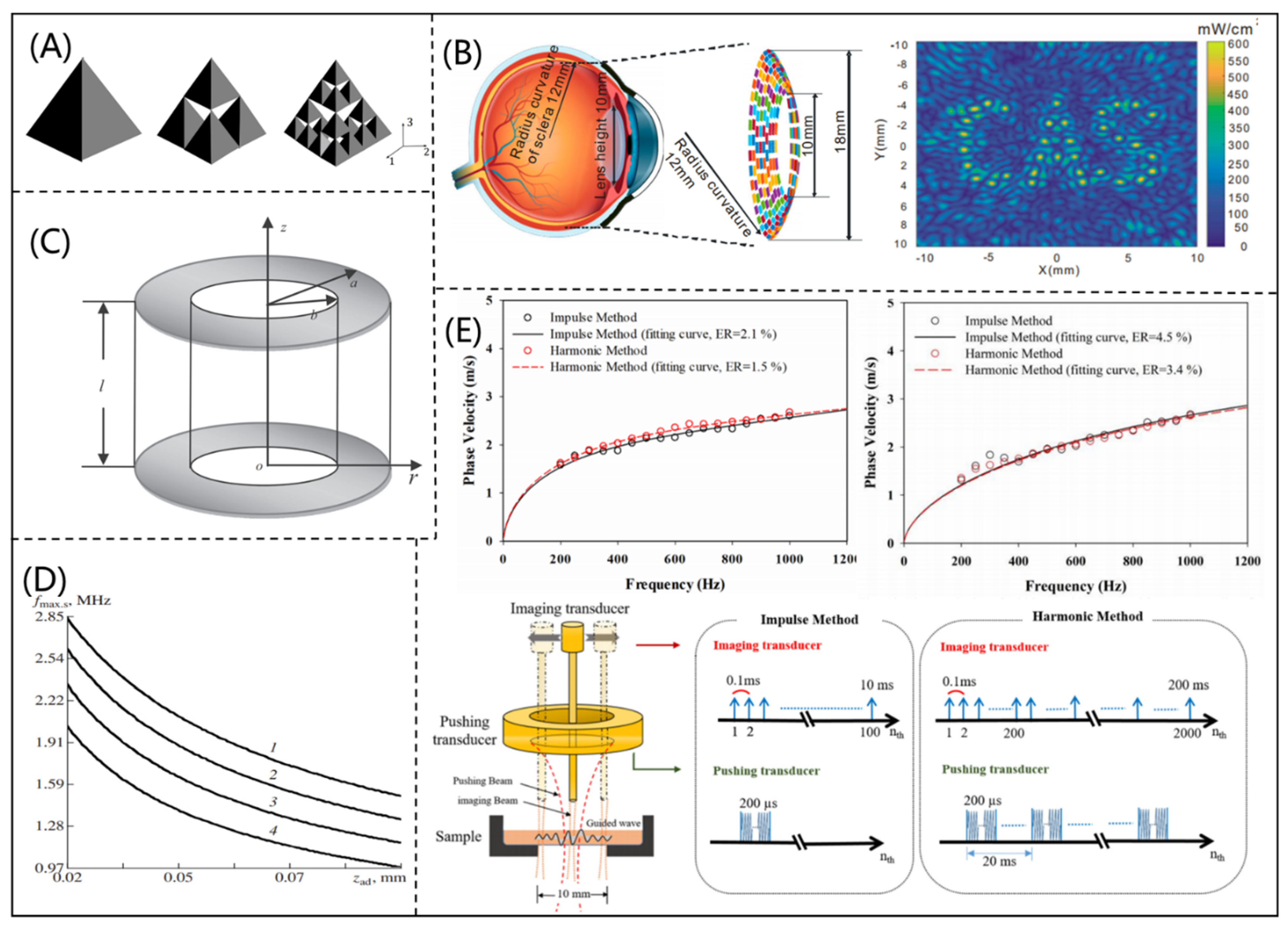
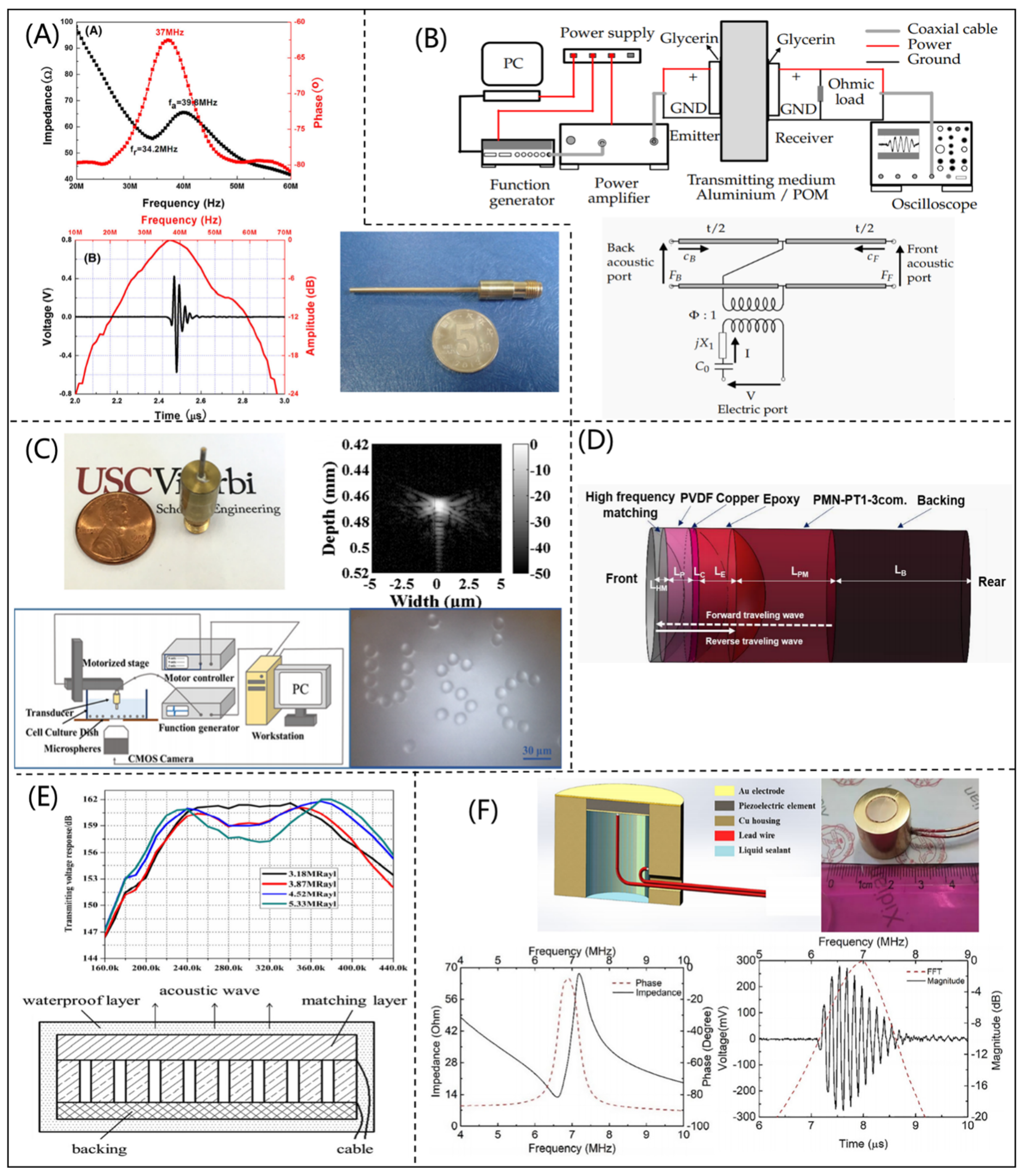
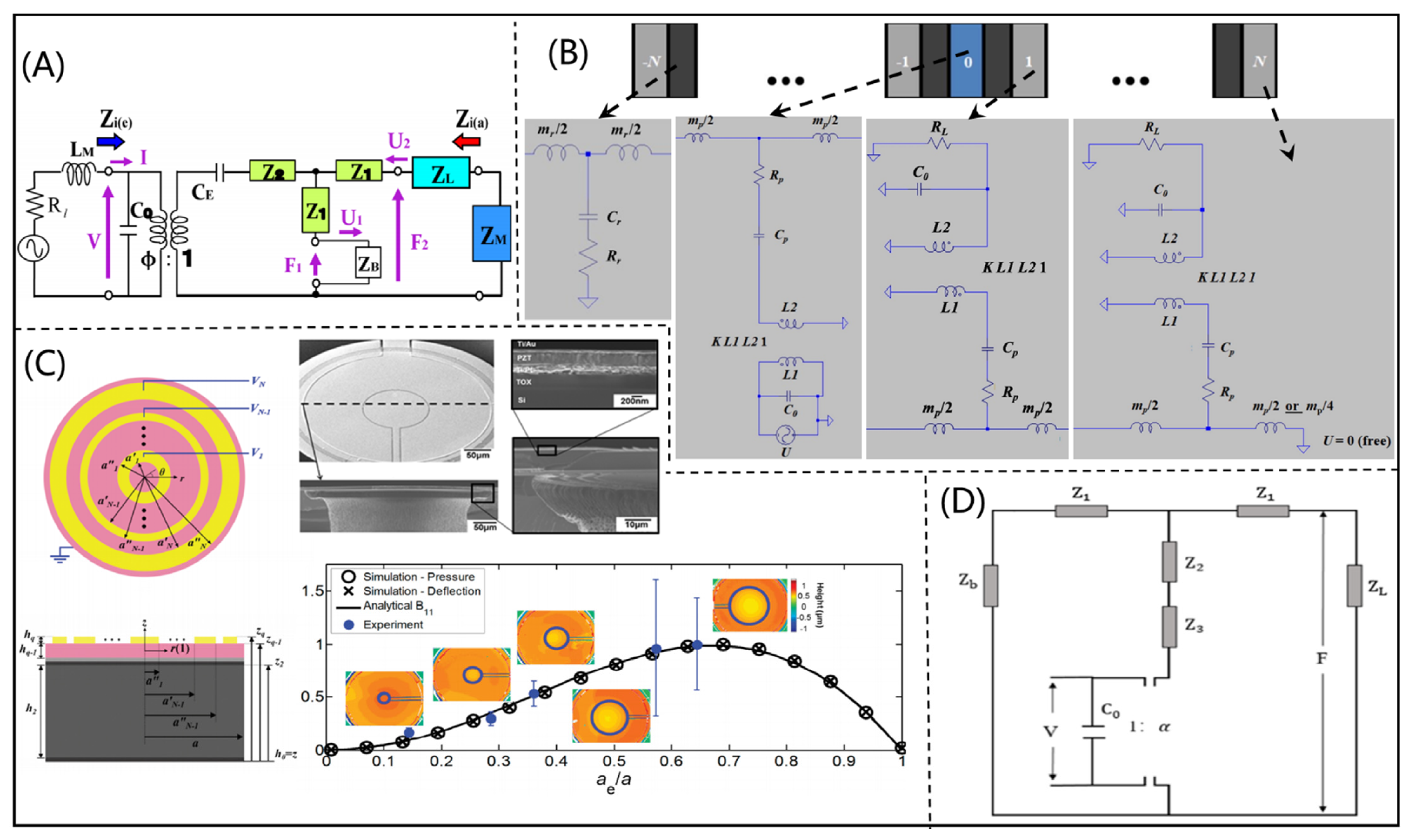
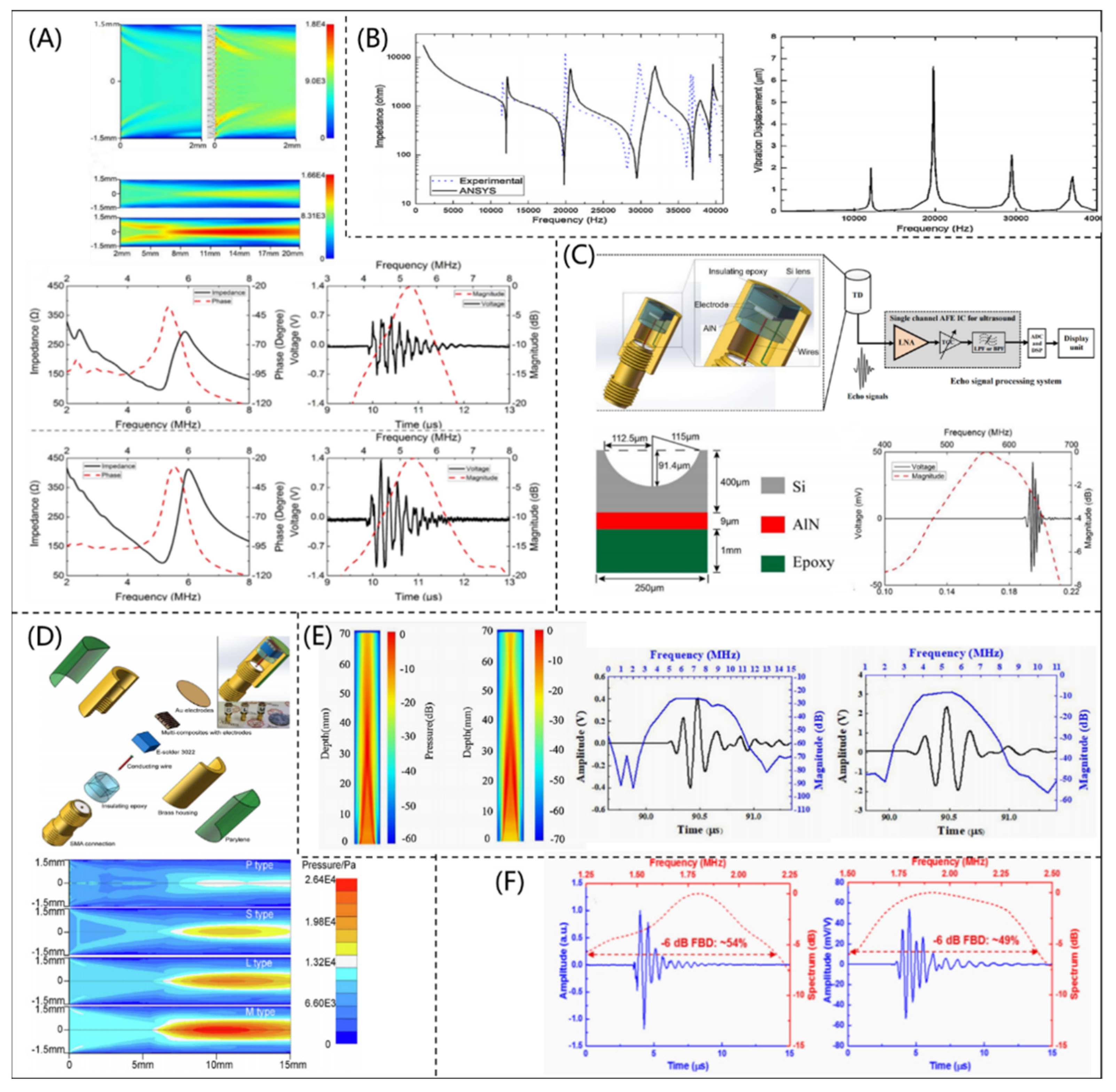
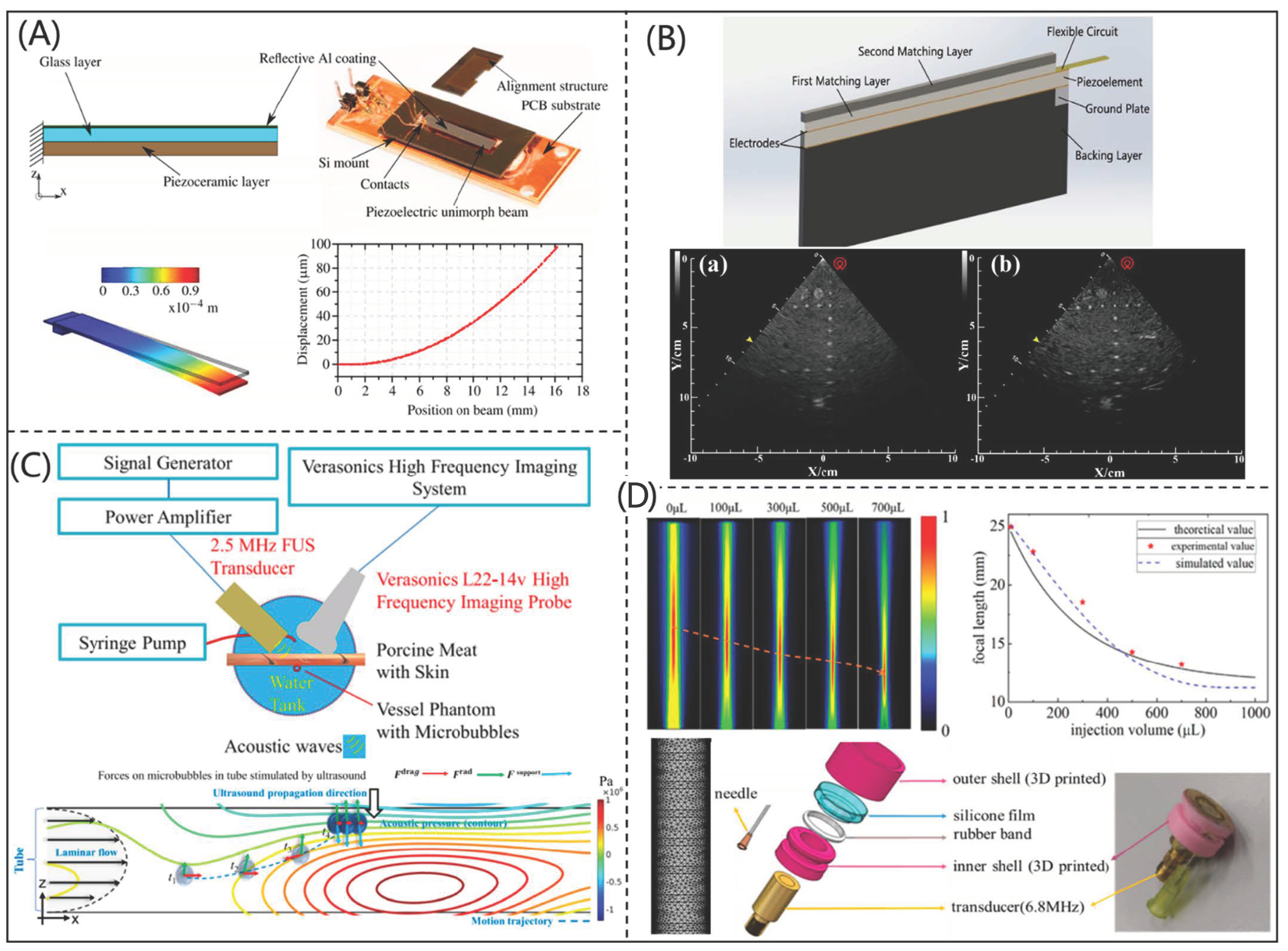

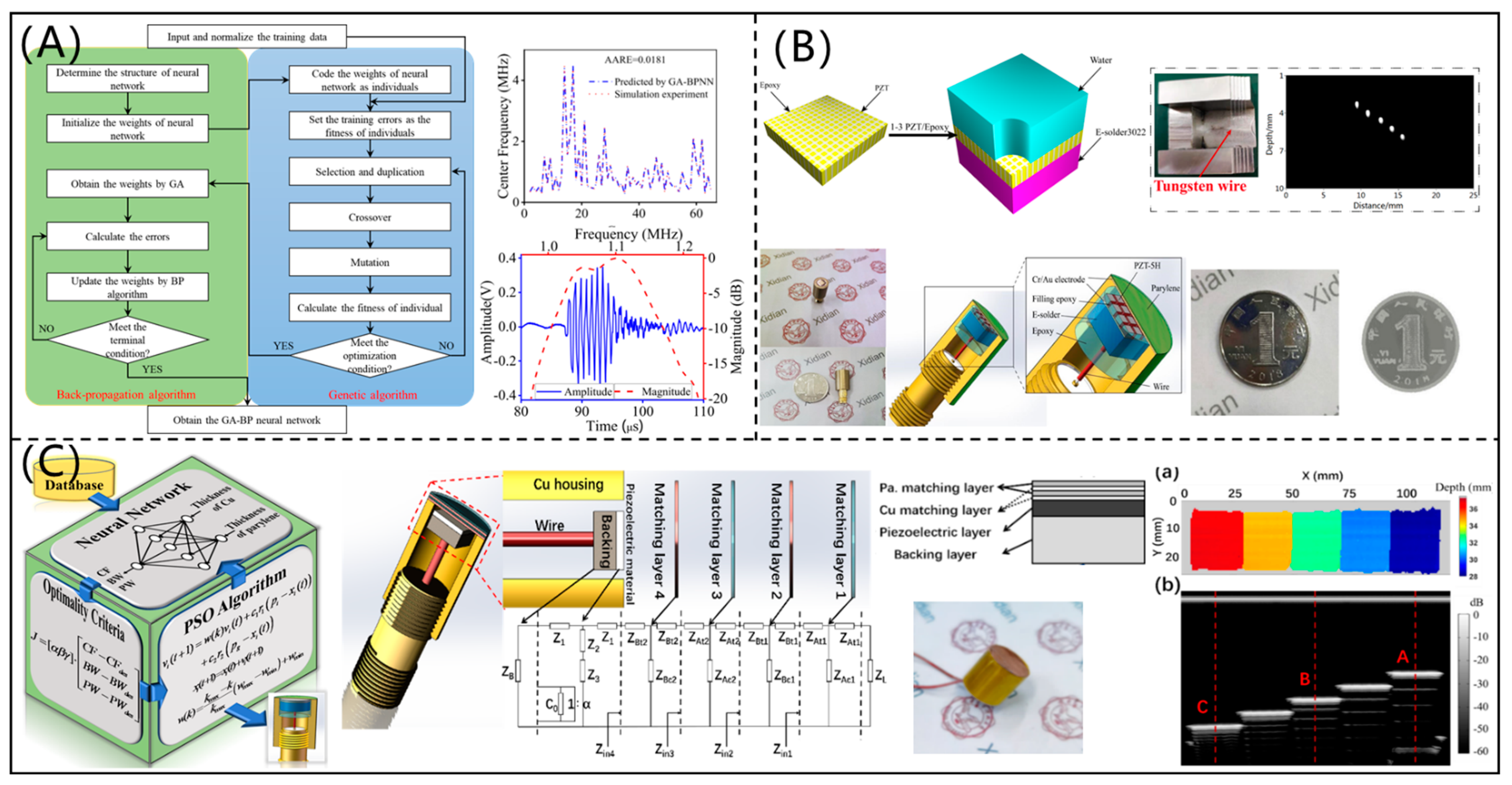
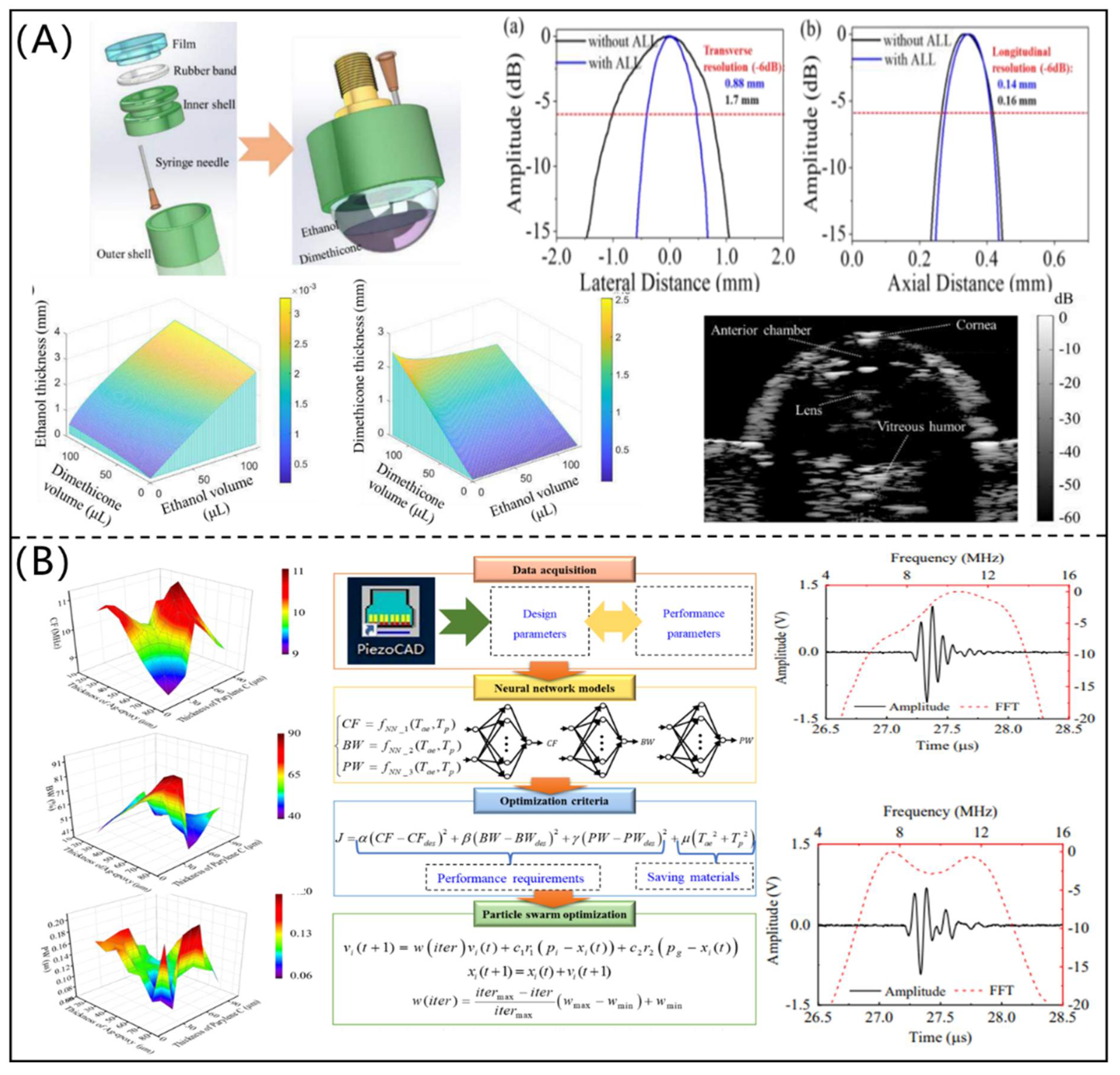
| Methods | Advantages | Disadvantages | |
|---|---|---|---|
| Traditional optimization design methods | Analytical model | Easy and rapid calculation, simple model | Low accuracy, relying on the experience of expert |
| Equivalent circuit model | Easy and rapid calculation, simple and accurate model | Finite parameters considered in this model, relying on the experience of an expert | |
| Finite element model | High accuracy, comprehensive model | Large calculation and memory, relying on the experience of an expert, long design cycle | |
| Efficient optimization design methods | Traditional model | Simple method, high efficiency, low design cycle | Limitation of traditional models |
| Data-driven model | High efficiency, high reliability, low design cycle | Requiring large amount of data | |
Publisher’s Note: MDPI stays neutral with regard to jurisdictional claims in published maps and institutional affiliations. |
© 2021 by the authors. Licensee MDPI, Basel, Switzerland. This article is an open access article distributed under the terms and conditions of the Creative Commons Attribution (CC BY) license (https://creativecommons.org/licenses/by/4.0/).
Share and Cite
Chen, D.; Wang, L.; Luo, X.; Fei, C.; Li, D.; Shan, G.; Yang, Y. Recent Development and Perspectives of Optimization Design Methods for Piezoelectric Ultrasonic Transducers. Micromachines 2021, 12, 779. https://doi.org/10.3390/mi12070779
Chen D, Wang L, Luo X, Fei C, Li D, Shan G, Yang Y. Recent Development and Perspectives of Optimization Design Methods for Piezoelectric Ultrasonic Transducers. Micromachines. 2021; 12(7):779. https://doi.org/10.3390/mi12070779
Chicago/Turabian StyleChen, Dongdong, Linwei Wang, Xingjun Luo, Chunlong Fei, Di Li, Guangbao Shan, and Yintang Yang. 2021. "Recent Development and Perspectives of Optimization Design Methods for Piezoelectric Ultrasonic Transducers" Micromachines 12, no. 7: 779. https://doi.org/10.3390/mi12070779
APA StyleChen, D., Wang, L., Luo, X., Fei, C., Li, D., Shan, G., & Yang, Y. (2021). Recent Development and Perspectives of Optimization Design Methods for Piezoelectric Ultrasonic Transducers. Micromachines, 12(7), 779. https://doi.org/10.3390/mi12070779










